The product recommendations in this post are recommendations by the writer and/or expert(s)
interviewed and do not contain affiliate links. Meaning: If you use these links to buy
something, we will not earn a commission.
When you need a snack that is quick, convenient, easy to take on the go, and full of nutrients, smoothies are a great choice—especially when you can make them at home and have more oversight and control over the ingredients used. Smoothies have the potential to provide your body with healthy ingredients like fruit, vegetables, nut butters, milk, protein powder, seeds, and so forth. However, there are some commonly used unhealthy smoothie ingredients that may derail the dietary benefits of these beverages.
Fruit, vegetables, nuts, and seeds can add a boost of protein, fiber, vitamins, and healthy fats to your frozen drink, which are aspects of a smoothie that can make it such a healthy part of your day. On the other hand, ingredients like sugary yogurt, sweeteners, ice cream, and fruit juice can come packed with ingredients that can detract from your smoothie’s potential nutritional value, leaving you with a drink that is high in added sugars and unhealthy fats yet low in helpful nutrients like fiber and protein.
To help you make your own creamy, delicious, nutrient-dense smoothies at home, we’ve rounded up a list of unhealthy smoothie ingredients you’re better off avoiding. Do know that you don’t need to avoid all of these ingredients forever, as treating yourself is integral to achieving healthy balance—no just in what you consume, but also in life. But recognizing which unhealthy smoothie ingredients to steer clear of will hopefully give you a more concrete understanding about the impact the ingredients in the foods you eat can have on your overall health and wellness.
Keep reading to find out which unhealthy smoothie ingredients are not worth adding to your blender—then for more tips on how to blend a healthy smoothie that can benefit your body, check the 5 Best Smoothie Recipes for Your Metabolism.
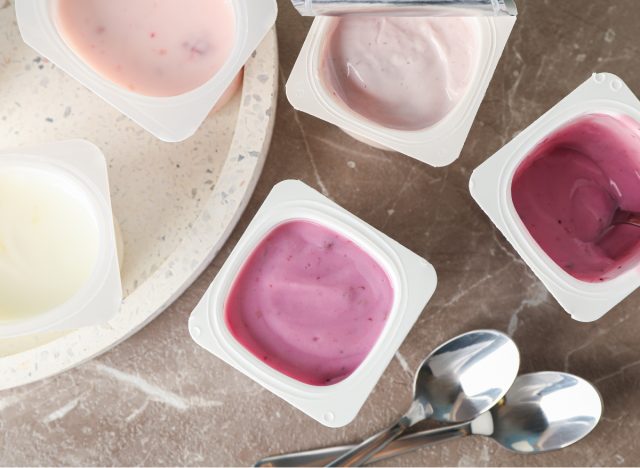
One of the most common ingredients that people put in their smoothies for an added texture of creaminess is yogurt. Many plain yogurts, especially Greek or Icelandic yogurts, come with a lot of protein and very little added sugar. For example, Fage 0% Greek Yogurt has 18 grams of protein and 5 grams of sugar—none of which are added. This can give your smoothie a nutrient boost and help keep you full longer.
However, your smoothie can quickly turn into a sugar bomb if you grab the wrong yogurt. Most varieties of flavored yogurts are loaded with added sugars, and often times if they advertise themselves as “fat-free” or “low-fat,” they may be adding even more sugar to compensate for the lack of fat. As an example, Dannon Low-fat Vanilla Yogurt may only have 2 grams of total fat, but it has 22 grams of sugar, 13 of which are added. Stonyfield Organic Fat-Free Chocolate Underground Yogurt has zero grams of fat but 19 grams of sugar and 13 grams of added sugar.
If you take into account that your smoothie may already have sugar from things like fruit, milk, and nut butter, you might want to opt for the low-sugar, high-protein yogurt varieties instead.
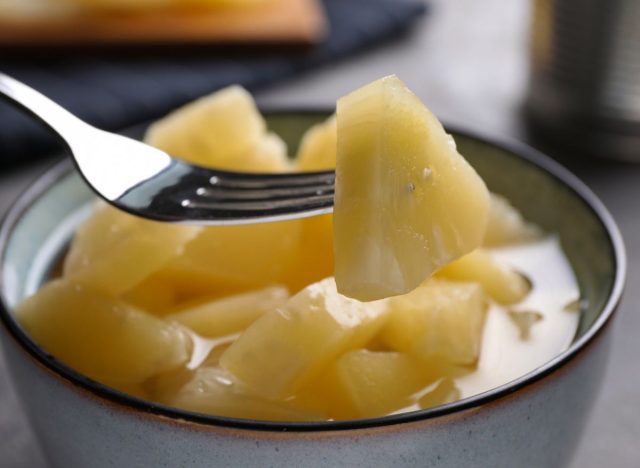
Canned fruit may seem like the quickest, cheapest, and most convenient option for adding your favorite produce to your smoothie, but most varieties of canned fruit are going to come packed in syrups that add onto your final sugar count. For example, the Dole Tropical Fruit Salad has 11 grams of added sugar per half cup.
To avoid added sugars and to just embrace the natural sugars in fruit, try sticking to fresh. Frozen fruit is even better for smoothies because it maintains the nutritional value, doesn’t go bad as quickly, and adds a creamier texture to your smoothie.
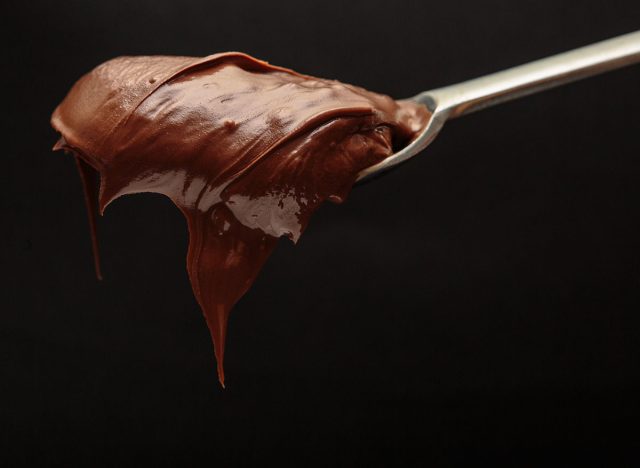
Hazelnuts are just a nutritious as any other nut, loaded with vitamins, minerals, antioxidants, and healthy fats. Chocolate can also provide a host of health benefits for your body because of the antioxidants in the cocoa. So, it’s easy to assume that when these two ingredients are combined to make a nut buttery spread like Nutella it would be fairly healthy. Before dropping a dollop of chocolate-hazelnut butter like Nutella into your smoothie, it’s important to also consider the other ingredients you also intend to use to ensure your smoothie actually strikes a healthy, nutritious balance. For instance, if whipping up a smoothie that already uses peanut butter, throwing some of this chocolate-hazelnut spread may add a burst of sweet flavor will certainly yield delicious results. However, if you’re trying to lose weight or your doctor has advised you to scale back on sugars and fats, you may want to skip this ingredient. Nutella and the like will only increase the fat (4.6 grams), saturated fat (1.6 grams), and sugar (8.4 grams) content of your smoothie.

You’ve finished adding in your smoothie ingredients and you feel like incorporating some more sweetness. Instead of reaching for plain sugar, you decide to try something more “natural” and instead grab the honey or maple syrup. Unfortunately, these natural sweeteners may be less processed, but they still add a ton of sugar to your beverage. For example, just one tablespoon of honey has 17 grams of sugar. In maple syrup, one tablespoon will still tack on 12 grams of sugar.
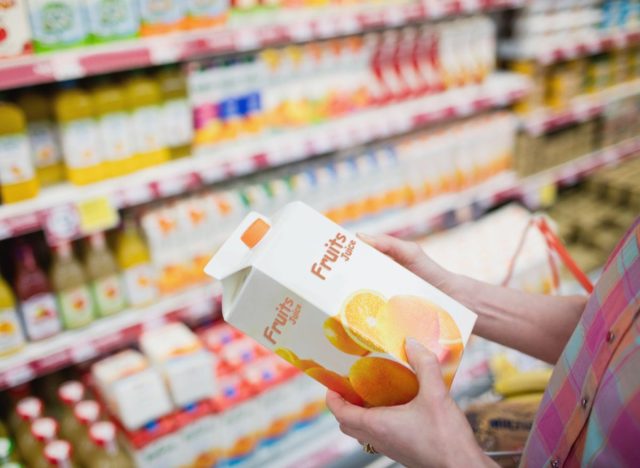
Similarly to the reason you may want to avoid flavored yogurt, adding fruit juice is just going to increase the amount of sugar going into your smoothie. For starters, you’ll absolutely want to steer clear of store-bought fruit cocktails posing as “real juice.” Items like the Minute Maid Cranberry Cocktail, which has 53 grams of added sugar, or Simply Fruit Punch, which has 21 grams of added sugar, are nothing more than water, sugar, fruit juice concentrate—so really, there is not much nutritional value to speak of.
If you’re wanting a liquid base for your smoothie, you’re better off finding a milk option that works for you. For instance, 2% cow’s milk still has 12 grams of sugar, but it also yields 8 grams of protein, as well as vitamin A, D, choline, calcium, and potassium. When you’re needing a non-dairy option, you can try something like Elmhurst Milked Almonds, which has 1 gram of sugar and 5 grams of protein, or Ripple Plant-Based Milk, which has 8 grams of protein, zero grams of sugar, and plenty of vitamins B12, D, and calcium.

Technically, a smoothie with alcohol in it is probably just a daiquiri, but either way, it’s better to limit your consumption of boozy, frozen fruit drinks and save them for special occasions. Not only will the combination of liquor and the rest of your smoothie ingredients add on a ton of calories and sugar, but when you throw booze into the mix, it becomes harder to stick to only one drink. Not only that, but research has shown that drinking alcohol can make your brain think that it needs food—a phenomenon that explains the hunger and cravings you get when you’ve had a bit too much to drink.
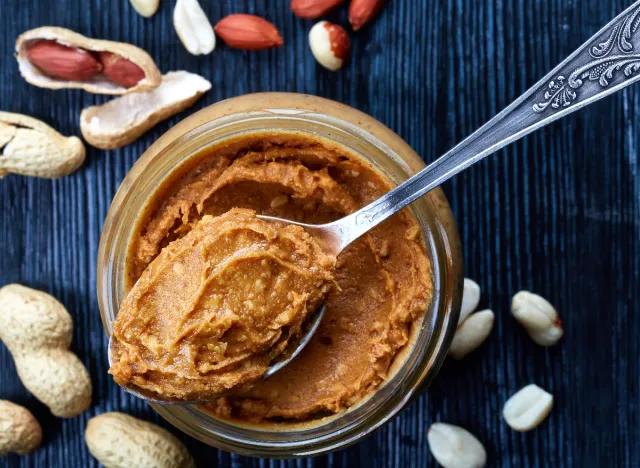
There are some common smoothie ingredients, such as nut butters, avocado, and coconut oil, that are considered healthy and provide the consumer with a burst of helpful nutrients, vitamins, and minerals. However, there is always the possibility of “too much of a good thing” in the case of smoothies, so it’s important to watch your portion sizes.
For instance, avocados are made up of healthy monounsaturated fats, which have been found to help improve heart health and cholesterol levels. However, in one avocado, there are 22 grams of fat, which is high for just one smoothie ingredient. While avocados are a source of healthy fat, the National Library of Medicine states that too much of any type of fat, even monounsaturated, can lead to weight gain. The same can be said about nut butters, which often contain healthy fats, but should still be consumed in moderation.
In a similar vein, tossing a scoop of coconut oil into your smoothie can provide your body with nutrients that may boost energy levels, improve oral health, and might even contribute to a reduced risk of cognitive decline and Alzheimer’s disease. Unfortunately, coconut oil—even though it’s nutrient-dense—is still a source of saturated fat, which means it should be consumed in moderation. For example, one report published in Circulation found that compared to many other oils, coconut oil may increase our LDL cholesterol levels more.

Now, we know it can be tempting to throw in your favorite ice cream or frozen yogurt to make that smoothie extra sweet and creamy. But, unless you’re fine with your smoothie turning into a dessert-style milkshake (which sounds delicious, to be honest), you may want to steer clear of the ice cream and find another way to add texture to your drink if you’re looking for a more nutrition-friendly beverage.
There’s one trick you can try in order to maintain the frozen creaminess of the ice cream without the added calories and sugar. Instead of going for a carton of your favorite ice cream, grab some low-sugar, high-protein yogurt and freeze it ahead of time! This will give you that desired texture while adding a boost of nutrients.


